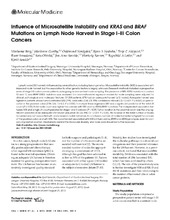Influence of microsatellite instability and KRAS and BRAF mutations on lymph node harvest in stage I–III colon cancers
Berg, Marianne; Guriby, Marianne; Nordgård, Oddmund; Nedrebø, Bjørn Steinar Olden; Ahlquist, Terje Cruickshank; Smaaland, Rune; Oltedal, Satu; Søreide, Jon Arne; Kørner, Hartwig; Lothe, Ragnhild A.; Søreide, Kjetil
Peer reviewed, Journal article
Published version
Permanent lenke
https://hdl.handle.net/1956/9080Utgivelsesdato
2013Metadata
Vis full innførselSamlinger
Originalversjon
https://doi.org/10.2119/molmed.2013.00049Sammendrag
Lymph node (LN) harvest is influenced by several factors, including tumor genetics. Microsatellite instability (MSI) is associated with improved node harvest, but the association to other genetic factors is largely unknown. Research methods included a prospective series of stage I–III colon cancer patients undergoing ex vivo sentinel-node sampling. The presence of MSI, KRAS mutations in codons 12 and 13, and BRAF V600E mutations was analyzed. Uni- and multivariate regression models for node sampling were adjusted for clinical, pathological and molecular features. Of 204 patients, 67% had an adequate harvest (≥12 nodes). Adequate harvest was highest in patients whose tumors exhibited MSI (79%; odds ratio [OR] 2.5, 95% confidence interval [CI] 1.2–4.9; P = 0.007) or were located in the proximal colon (73%; 2.8, 1.5–5.3; P = 0.002). In multiple linear regression, MSI was a significant predictor of the total LN count (P = 0.02). Total node count was highest for cancers with MSI and no KRAS/BRAF mutations. The independent association between MSI and a high LN count persisted for stage I and II cancers (P = 0.04). Tumor location in the proximal colon was the only significant predictor of an adequate LN harvest (adjusted OR 2.4, 95% CI 1.2–4.9; P = 0.01). An increase in the total number of nodes harvested was not associated with an increase in nodal metastasis. In conclusion, number of nodes harvested is highest for cancers of the proximal colon and with MSI. The nodal harvest associated with MSI is influenced by BRAF and KRAS genotypes, even for cancers of proximal location. Mechanisms behind the molecular diversity and node yield should be further explored.
